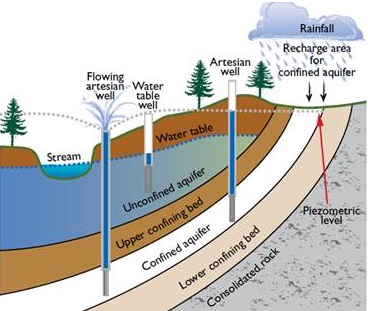What is Artesian Water?
In the Roman City of Artesium, in what is now known as the region of Artois in France, early man discovered that water collecting in underground aquifers was pressurized by gravity as it continually fed the aquifer. The Romans drilled holes in the earth's surface, thus releasing the pressure and the water for human consumption. Technically, Artesian water is water from an Artesian well, which relies on naturally occurring gravitational pressure to force water to the earth's surface. These wells exist all over the planet, and the purity of the water they produce depends on the precipitation, air pollution and mineral content of the earth surrounding the aquifer.
The earth and it's atmosphere naturally produces all kinds of water. Water from the lakes, rivers and oceans evaporate into the atmosphere, condenses and falls back down to the earth in the form of precipitation, rain and snow. Along the way it collects all sorts of material, organic and inorganic. Some of it is good, like naturally occurring minerals, and some of it is bad, like pollution, bacteria, pathogens and man made contaminants like chemicals and other toxins. And so it makes sense that water that evaporates from the cleanest parts of the world has the highest purity when it comes back down to earth and collects in underground aquifers. And the cleaner the rock and surrounding sediment that acts as a natural filter, the cleaner the water. And if that natural filtration process features water passing through thousands of feet of volcanic rock before it gathers in the aquifer, then you get just about the cleanest, purest drinking water available on earth.
What Are Some of the Characteristics of Artesian Water?
As mentioned above, because of the varying climate and geological factors around the globe, each Artesian well will produce it's own unique water with its own unique characteristics. For example, the soil in the Artois region in France is rich in clay and limestone, which gives well water a pleasant alkaline taste with elevated levels of pH. The same holds for spring water from places like Hawaii, whose soil content is rich in volcanic ash, which yields a soil texture of silt and sometimes clay. Regardless of where the aquifer is, Artesian water generally will have these qualities:
Contained: The water will be preserved in a contained aquifer, protected by a layer of rock, which in most cases will act as a filter as the water passes through it.
Protected: This same layer of rock will stay protected from external contaminants
Sloped: In order for enough pressure to build up and force ware to the earth's surface without the aid of a pump or a machine, the well must be located near or toward the bottom of a slope.
Where Does the Best Artesian Water Come From?
This is obviously subjective based on taste and other factors, but the islands in the Pacific are generally accepted to be the best source of Artesian drinking water, especially if it is bottled at the source. Prevailing trade winds keep the air clean and clear of pollutants, and the remote island location surrounded by water also helps. Add in the temperate climate and reliable rainfall, and the lava rock filtration, and you have the ideal environment for Mother Nature to produce the best tasting, naturally alkaline water on the planet. Brands like Fiji and Hawaiian Springs Water have done well in capturing this 'magic' water in a bottle, and they have fans all over the world who love the soft mouth feel and mineral taste.
Read more about Artesian Springs here.
Photo by Svetlana Gumerova on Unsplash
Like us on Facebook



 The word artesian comes from the town of Artois in France, the site of the old Roman city of Artesium, where the world’s most famous free flowing wells were drilled centuries ago during the Middle Ages.
The word artesian comes from the town of Artois in France, the site of the old Roman city of Artesium, where the world’s most famous free flowing wells were drilled centuries ago during the Middle Ages.